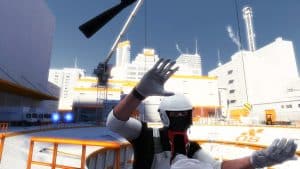Mirror’s Edge
Related Games
Description
🔥 What is Mirror’s Edge for PC
Mirror’s Edge is a first-person action-adventure game developed by DICE and published by Electronic Arts, released originally for PC in 2009 after its console debut. The game stands out for its unique focus on parkour-style movement rather than traditional shooting mechanics, setting it apart from most first-person titles of its time. Players step into the shoes of Faith Connors, a skilled “Runner” who delivers sensitive information across the rooftops of a futuristic city where communication and freedom are tightly controlled by an authoritarian regime.
The world of Mirror’s Edge is defined by its striking contrast between calm minimalist design and the tension of constant surveillance. The narrative follows Faith as she becomes entangled in a conspiracy after her sister is framed for murder, forcing her to challenge the oppressive government while racing across dizzying heights and sterile cityscapes. The story isn’t long, but it delivers an intense blend of urgency and rebellion that perfectly matches the game’s physicality.
Mirror’s Edge belongs to a small but influential group of games that redefined what first-person perspective could feel like. Instead of emphasizing combat, it highlights rhythm, momentum, and precision. Every jump, slide, and wall-run is a test of timing, reflexes, and trust in your own sense of movement, making it an experience that feels deeply physical and immediate.
👉 Features of Mirror’s Edge
Immersive First-Person Parkour
Mirror’s Edge pioneered a fluid parkour system that lets players vault, slide, wall-run, and leap across rooftops with intuitive controls. Unlike most first-person games, your character’s arms, legs, and body are visible, creating a tangible sense of presence and speed. Movement feels rhythmic, and maintaining momentum becomes the key to survival. Small visual cues like the red “runner vision” highlights guide players through routes without intrusive markers.
Clean Futuristic Art Direction
The game’s world is rendered in bright whites, sharp reds, and soft blues, creating a striking and sterile city that feels both beautiful and oppressive. This minimalist design helps players focus on movement while subtly reflecting the world’s political control. The art direction isn’t just aesthetic it supports gameplay by clearly marking paths and obstacles through color.
Minimal HUD and Natural Feedback
DICE designed Mirror’s Edge to immerse players without cluttering the screen. There’s no heavy interface, just Faith’s breathing, footsteps, and heartbeat to indicate stress or damage. The sound design and visual motion blur make every fall and sprint feel visceral. It’s a design that keeps the player fully in the moment, relying on instinct instead of statistics.
Emotional Storytelling Through Action
Faith’s story unfolds naturally through gameplay and short in-engine cutscenes. Her perspective as a courier fighting against control gives the narrative emotional weight, even when the plot is minimal. The city’s silence and its absence of civilians make Faith’s runs feel lonely yet purposeful, turning the act of movement itself into a form of resistance.
Optional Combat and Non-Lethal Choices
Although Mirror’s Edge includes disarming and hand to hand combat, players are encouraged to avoid direct confrontation whenever possible. Faith can steal weapons briefly, but using them slows her down and breaks the flow of movement. This balance reinforces the game’s central theme of freedom through agility rather than violence.
Gameplay
Momentum and Flow
At the core of Mirror’s Edge is a rhythm-based flow system where momentum dictates speed and survival. Players must chain actions smoothly running, sliding, wall-jumping, and vaulting to maintain velocity. Stopping breaks the flow and makes Faith more vulnerable to enemies and falls. The sense of inertia is finely tuned; every motion feels earned through skill and precision.
Navigation and Exploration
Levels are semi-linear but filled with alternate paths and shortcuts for experienced players. Mastering routes becomes part of the game’s satisfaction, as you learn to read environmental cues quickly. Runner Vision, which highlights critical objects in red, acts as a subtle guide without removing the challenge of exploration. Timed trials and speedrun modes reward mastery and creativity, turning repetition into practice rather than punishment.
Chase and Escape Sequences
Some of Mirror’s Edge’s most memorable moments come from intense chase sequences where players must stay one step ahead of heavily armed pursuers. These moments blend cinematic pacing with full player control, making every escape feel urgent and personal. Missing a jump or mistiming a slide can mean instant failure, which heightens the tension but also makes success deeply rewarding.
Combat and Avoidance
Combat is fast and minimal. Faith can disarm opponents, use acrobatic kicks, and redirect enemy momentum, but prolonged fighting breaks her flow. The best strategy is usually to run, using the environment to outmaneuver rather than overpower. This design decision reinforces her identity as a messenger, not a soldier, and aligns with the game’s anti-authoritarian tone.
Graphics
Distinctive Minimalist Visuals
Mirror’s Edge stands out visually through its clean, almost sterile aesthetic. The city is a mosaic of white concrete, glass, and metal accented by strong primary colors. The minimalist design creates clarity during fast movement and conveys a sense of oppressive control. The contrast between bright surfaces and deep shadows amplifies the sensation of height and exposure.
Lighting and Environmental Storytelling
Lighting plays a major role in setting mood and direction. Warm tones signal freedom and safety, while cold, desaturated lighting often marks areas controlled by the regime. The skyline, dotted with reflective skyscrapers and empty streets, tells a silent story about a world obsessed with order and surveillance. Even without heavy dialogue, the city feels alive with tension.
Animation and First-Person Perspective
Faith’s animations are crucial to the game’s realism. Seeing her arms swing, legs kick, and body react to landings creates a direct physical connection between player and character. The animation quality enhances immersion by grounding movement in believable motion, making every leap feel dangerous and exhilarating. Camera motion and depth of field contribute to a genuine sense of vertigo.
Performance and Technical Details
Mirror’s Edge runs smoothly even on moderate hardware, with scalable settings for texture quality, lighting, and anti-aliasing. The high frame rate makes parkour more responsive, while clean textures ensure the aesthetic remains timeless. Although the environments are not densely populated, the design choices give the illusion of a vast, controlled metropolis.
Pros and Cons
✔️ Pros
- Innovative first-person parkour system that feels fluid and unique
- Distinct minimalist art direction that enhances both style and gameplay
- Immersive sound design and minimal HUD for deep player engagement
- Strong sense of physical presence and movement rhythm
- Satisfying challenge for players who enjoy mastering precision and timing
❌ Cons
- Short main story with limited replay value outside time trials
- Occasional frustration due to trial-and-error platforming
- Combat sections can feel awkward compared to movement
- Narrative and characters are underdeveloped compared to the game’s world
ℹ️ Game information
⭐ Installation Instructions
- The game is fully complete, you just need to install it, so there is no need to unpack it or download it from other sources.
- Just run the Mirror’s Edge.exe installation file.
- Simply launch the game from shortcut desktop.
⚙️ System Requirements
✅ Minimum:
- OS: Windows XP/Vista
- Processor: Intel Core i5-1300F
- Memory: 1 GB RAM
- Graphics: NVIDIA GeForce 6800
- DirectX: Version 9.0c
- Network: Broadband Internet connection
- Storage: 8 GB available space
Images














